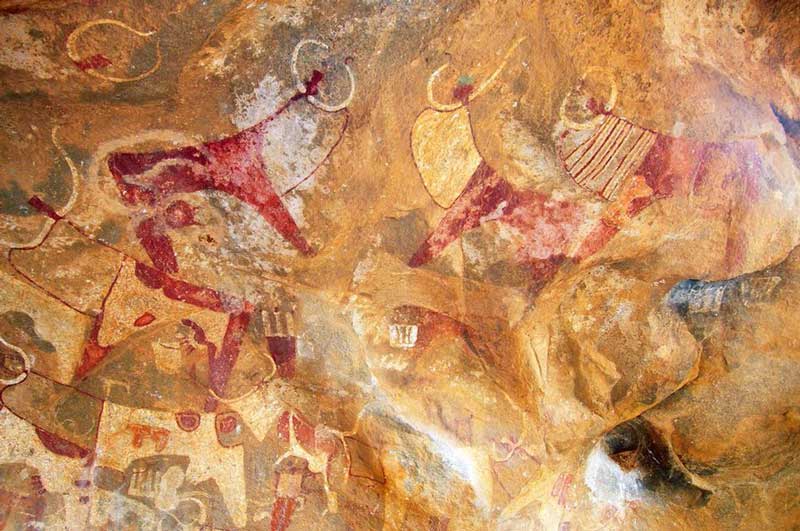
Located on the rural outskirts of Hargeisa, the capital and largest city of Somaliland, a self-proclaimed country that technically and according to the United Nations, is a part of Somalia, Laas Geel are cave formations containing some of the earliest known cave paintings of domesticated African aurochs, an extinct cattle species, considered to be the wild ancestor of modern domestic cattle in the Horn of Africa, also known as Somali Peninsula.
It is a complex of rock shelters, placed on a granite outcrop that rises from a plateau at an altitude of around 3117 feet (950 m) above sea level, at the confluence of two seasonal rivers, which is a key factor to explain the meaning of its name. The word laas geel is made of two Somali words, laas and geel, which stands for well and camel respectively and refers to a source of water, from where the camels and other livestock drink, along with the local people.

Although the complex of rock art in Laas Geel had been known to the locals for centuries, they carefully avoided it, as they believed the area to be haunted by ghosts, demons and evil spirits. However, the world outside was not aware of the treasure trove until 2002, when a French team led by Xavier Gutherz from Paul Valery University and his team studying the beginning of Pastoralism in the Horn of Africa, discovered the Laas Geel caves, decorated with the spectacular paintings scattered among ten rock alcoves.
After that, a mission was sent again to Laas Geel in November 2003, when a team of experts undertook a detailed study of the paintings and their prehistoric context. The team discovered that the paintings are distributed in 20 rock shelters, the biggest being around 33 feet (10 m) long and along with the paintings, they also found stone tools, scattered throughout the site and tombs marked with stelae or upright stone slabs and mounds, scattered in the neighbourhood. Although little is known about the prevailing civilization at the time and the painting techniques used to create rock art in Laas Geel, scholars believe the paintings could be anywhere from 3500 to 2500 BC.

The rock art at Laas Geel contains about 350 animal and human representations, as well as numerous tribal marks, some of which are stunningly well preserved as they have been sheltered from the elements by the granite overhangs, while the others have faded due to rock degradation and the effects of weathering and erosion. The walls and ceiling of the caves contain colourful paintings in red, white, black, violet, brown and yellow, both isolated and combined, depicting mostly animals, mainly cows and dogs.
Other animals depicted in the artwork include monkeys, antelope, giraffes and possibly jackals or hyenas. Some also represent human figures, some in touching scenes, such as a woman giving water to a dog. However, the herders and wild animals appearing in the cave paintings suggest the interglacial period when the present Horn of Africa region was lush and green and home to many wild animals.

Nevertheless, cows are the most frequently depicted animal in the rock art paintings at Laas Geel, appearing isolated or in groups of up to fifteen, some in schematic outlines, while the others in elaborate detail with radiant neck stripes and decorated with what looks like traditional fabrics and ceremonial robes. The most distinctive feature of these cows is their necks, depicted as rectangular, abnormally wide and either blank or filled with red and white stripes, either straight or wavy, interpreted by the scholars as mats hanging from the actual neck and interpreted as ceremonial ornamentation. The bovines, painted at Laas Geel, are strangely depicted with heads appearing like beakers and situated close to the horns, often large ones, which could be possibly a symbol of fertility, meaningfully joining the body through a line, possibly representing the spine. These parts are combined in various colours, producing a complete polychrome figure. Unfortunately, although bovine bones were recovered from the excavation sites, they were not properly preserved to determine whether they belonged to domestic or wild bovines.

Although human representations are found in nearly all the artworks, the representations of the human figures at Laas Geel are ambiguous. Mostly associated with the herds, tiny human figures are often frontally depicted with small heads, arms outstretched to the sides and wearing a kind of shirt, usually white, painted in the same colours and techniques as the cattle, usually with chests striped in white or red. The figures may also represent hunters, as in some cases, they carry a bow, a stick or a shield. Along with the cattle, dogs are also well represented in the panels of artwork, usually positioned near the human figures.

Although officially a part of Somalia and no country has recognized Somaliland's independence so far, the self-proclaimed country of Somaliland has been practically an independent nation for the past three decades and is considered the most peaceful and prosperous region of Somalia, spared from the perpetual insurgency and instability that ravaged the rest of the horn of Africa. Due to its relative calmness, Somaliland has seen an increasing number of tourists, drawn by its virgin beauty and marvelling at the country's myriads of hidden gems, with Laas-Geel, one of Africa's finest rock art sites, standing out as a breathtaking relic of the earliest pastoral communities of mankind. But the archaeological site is now at risk of destruction, since apart from vandalism and clandestine excavation, wind propelled dust has been regularly creating dark coats on the invaluable ancient pictures on the rocks. Unfortunately, the ambiguous political status of Somaliland, since not recognized internationally, has prevented the historic artwork from being listed as a UNESCO World Heritage Site.